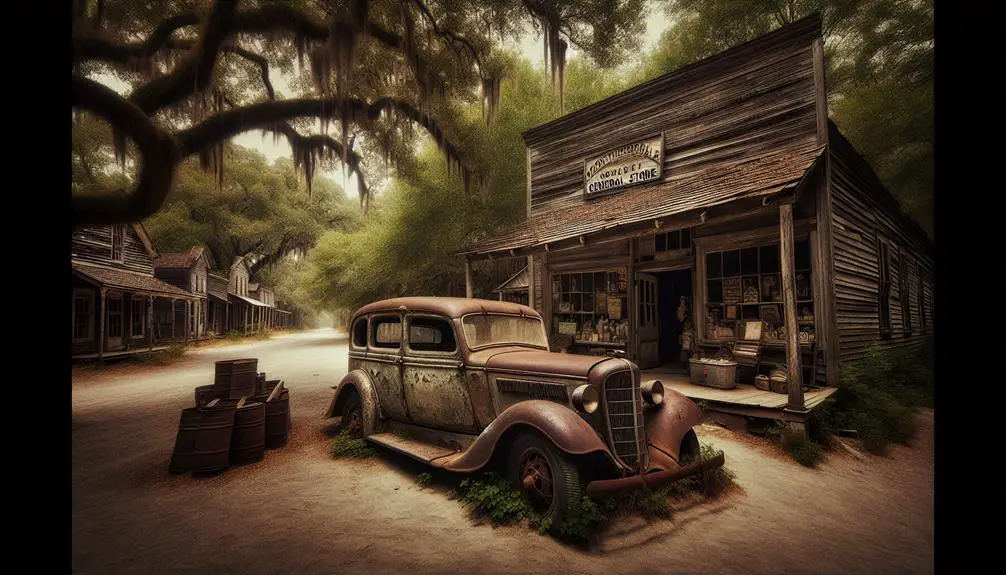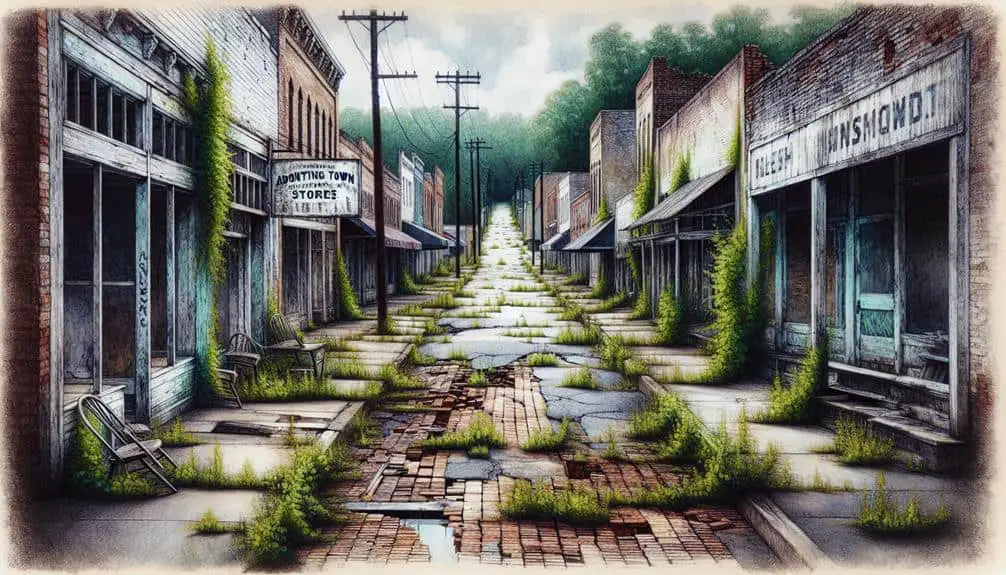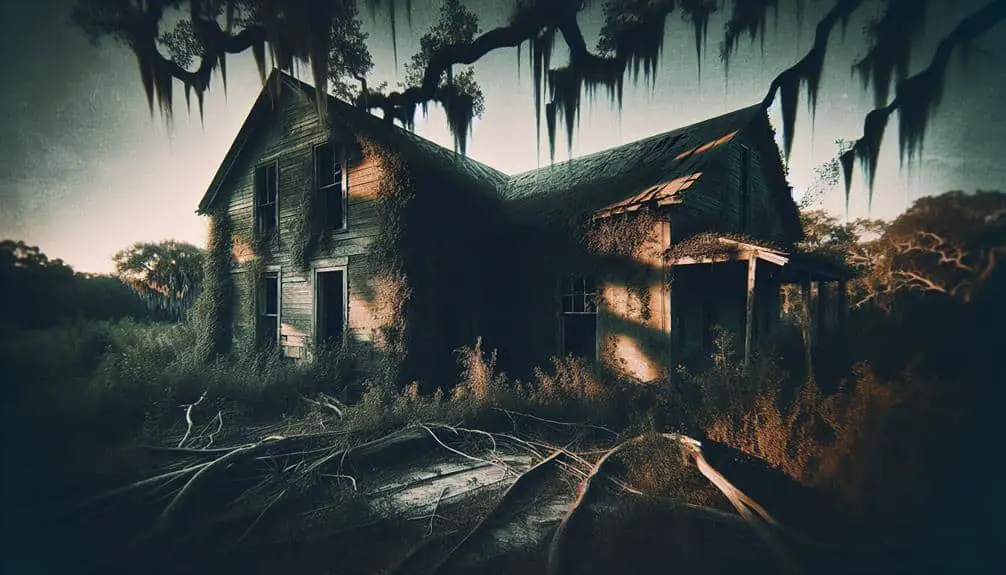When exploring abandoned Southern ghost towns off-grid, remember historical significance adds depth. Prepare for challenges: lack of amenities and wildlife encounters. Safety comes first; inform someone of your plans and carry a crucial phone. Watch for hidden dangers. Proper gear is essential – sturdy shoes, long pants, and gloves. Study maps and respect warning signs. Discover iconic landmarks showcasing past communities' stories. Preservation involves documentation and community engagement. Ready to uncover hidden tales and explore remnants of a once-thriving community?
Key Points
- Inform someone of your plans and carry a charged phone for safety.
- Wear proper gear like sturdy shoes and gloves in off-grid locations.
- Study maps, stay on marked paths, and respect warning signs.
- Be prepared for hidden dangers, wildlife encounters, and lack of amenities.
- Have an emergency plan in case of injury or getting lost.
Historical Significance of Southern Ghost Towns
Explore the intricate historical significance of Southern ghost towns, uncovering the unique stories and cultural remnants embedded within their deserted landscapes. These abandoned settlements hold a wealth of cultural heritage, providing a window into the past and a glimpse of the lives led by those who once inhabited these now desolate areas. The architectural ruins scattered throughout these ghost towns stand as silent witnesses to bygone eras, each cracked brick and weathered beam whispering tales of a time long forgotten.
As you investigate the heart of these abandoned communities, you'll uncover the layers of history that have shaped them. From the remains of old saloons to the dilapidated storefronts, each building tells a story of its own, offering a glimpse into the daily lives of the people who once walked these now empty streets. The cultural heritage preserved within these ghost towns serves as a reminder of the resilience and spirit of those who came before, leaving behind a legacy that continues to echo through time.
Challenges of Exploring Off-Grid Locations
Traversing the rugged terrain and unpredictable conditions of off-grid locations presents a myriad of challenges for those seeking to explore Southern ghost towns. Safety precautions become essential when venturing into these remote locations. The lack of cell service and limited access to emergency services heighten the risks associated with exploring these abandoned sites. It's vital to inform someone of your plans and expected return time before setting off on your adventure.
Navigating off-grid locations also means facing potential encounters with wildlife, such as snakes, coyotes, or even bears, depending on the region. Staying alert and being prepared with proper gear can help mitigate these risks. Additionally, the lack of basic amenities like running water or electricity adds another layer of difficulty to the exploration process. Carrying enough water, food, and emergency supplies is essential for your safety and well-being while exploring these ghost towns.
Despite the challenges, the allure of uncovering the history and stories hidden within these forgotten Southern ghost towns continues to attract adventurers looking for a taste of freedom and exploration.
Tips for Safe Exploration in Ghost Towns
When delving into ghost towns in the South, prioritizing your safety through strategic planning and preparation is vital.
Safety precautions are necessary when exploring abandoned locations. Always inform someone of your whereabouts and expected return time. Carry a fully charged phone and a first aid kit. Be aware of hidden dangers such as unstable structures, rusty metal, and wildlife. Proper gear is essential; wear sturdy shoes, long pants, and gloves. Bring a flashlight, water, and snacks. Have an emergency plan in place in case of injury or getting lost.
Study maps of the area beforehand and familiarize yourself with exit routes. Stay on marked paths and avoid restricted areas. Respect any warning signs you encounter.
Iconic Landmarks in Abandoned Southern Towns
As you venture into abandoned Southern towns, you'll encounter iconic landmarks that whisper tales of a bygone era. Among the most striking features are the architectural ruins that stand as silent witnesses to the once-thriving communities that now lie in urban decay. These towns hold remnants of grand mansions, dilapidated churches, and decaying factories, each telling a unique story of the past.
One such landmark is the crumbling cotton mill in the heart of a ghost town, its towering brick walls a reminder of the industrial boom that once fueled the region's economy. The intricate details of the mill's architecture speak of a time when it was a hub of activity, now reduced to a haunting shell.
Exploring these sites offers a glimpse into the history and culture of the Southern United States, where each crumbling facade and overgrown street serves as a poignant reminder of the passage of time and the resilience of a once-thriving community amidst the ravages of neglect.
Preserving the History of Ghost Towns
How can the rich history of ghost towns in the Southern United States be effectively preserved for future generations to explore and learn from?
Preserving these abandoned settlements involves a delicate balance between conservation and accessibility. One of the key preservation techniques is documentation. Detailed records, including photographs, maps, and oral histories, can capture the essence of a ghost town before it fades away entirely.
Community engagement is another crucial aspect of preserving ghost towns. Involving local residents, historians, and enthusiasts creates a sense of ownership and responsibility for these historical sites. Community-led initiatives such as clean-up events, historical reenactments, and educational programs can breathe new life into abandoned towns while honoring their past.
Moreover, creating partnerships with government agencies, historical societies, and academic institutions can provide additional resources and expertise in preserving ghost towns. By combining preservation techniques with community engagement, we can guarantee that the legacy of these ghost towns endures for generations to come.
Frequently Asked Questions
What Are Some Common Dangers or Hazards to Be Aware of When Exploring Abandoned Southern Ghost Towns Off-Grid?
Exploring abandoned southern ghost towns off-grid presents unique dangers. Safety precautions are essential. Be ready for wildlife encounters. Sharpen your navigation skills. Establish emergency protocols. Stay alert, embrace freedom, navigate cautiously, and enjoy the adventure.
Are There Any Legal Considerations or Restrictions When Visiting and Exploring Ghost Towns in the Southern United States?
When exploring ghost towns in the southern United States, legal implications must be considered. Access restrictions may vary, so make sure you research local laws beforehand to avoid potential issues and enjoy your adventure responsibly.
How Can One Prepare for Off-Grid Exploration in Terms of Supplies, Equipment, and Physical Fitness?
To prepare for off-grid exploration, make sure survival skills, wilderness navigation, and emergency preparedness are in excellent condition. Pack essential outdoor gear and prioritize physical fitness. With proper supplies and equipment, you'll be ready for any adventure.
Are There Any Lesser-Known or Hidden Ghost Towns in the Southern United States That Are Worth Exploring?
Seeking hidden gems in the Southern US for off-grid exploration? Uncover forgotten ghost towns that showcase historical preservation amidst urban decay. Venture where few tread, discovering the allure of forgotten stories and abandoned structures.
What Measures Can Individuals Take to Respect and Protect the Historical Sites and Artifacts They Encounter in Abandoned Southern Townships?
To respect and protect historical sites and artifacts in abandoned southern townships, follow preservation ethics. Minimize environmental impact by refraining from removing or damaging items. Take only photos, leave footprints. Preserve the past for future explorers.



